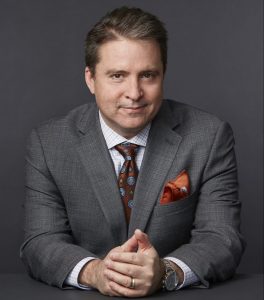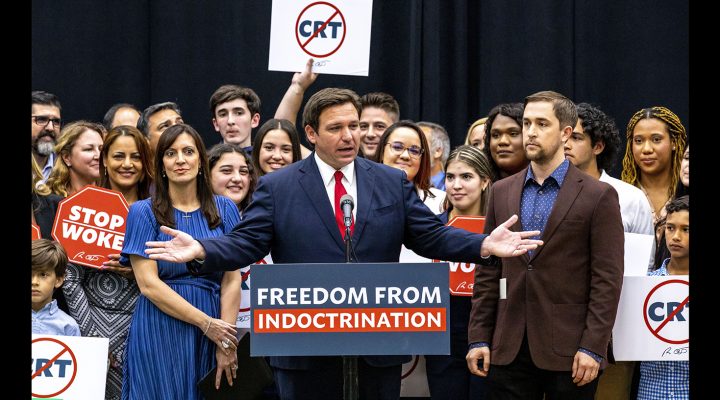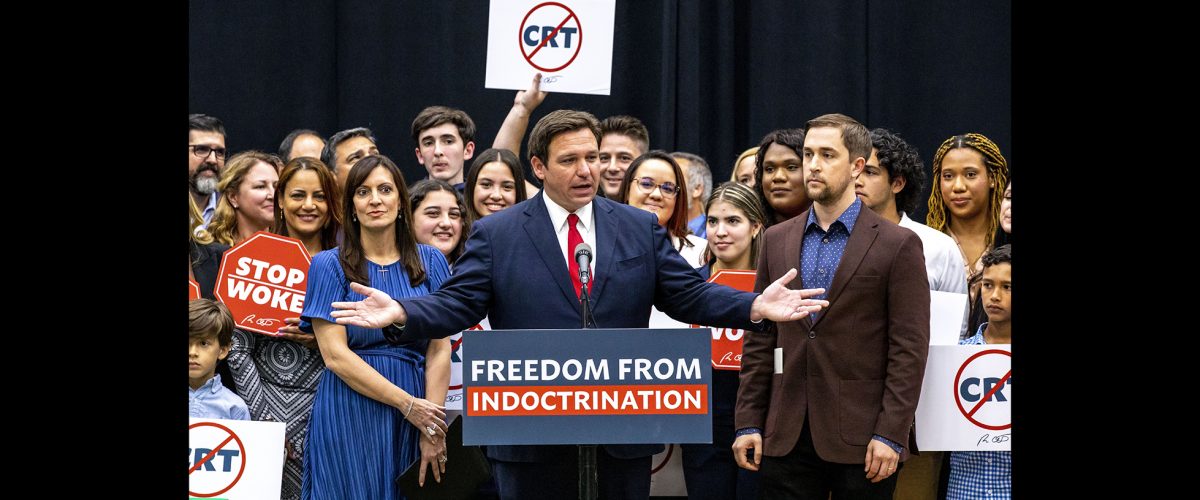Over the past few years, MAGA politicians and local activists have made education, especially the teaching of history, a hot spot in the culture wars — with the megaphone of Fox News.
In the waning days of his presidency, Donald Trump established the widely panned “1776 Project” to promote his vision of “patriotic education,” and Republican governors from Glenn Youngkin to Kay Ivey to Ron DeSantis have made banning so-called Critical Race Theory centerpieces of their administrations.

Robert P. Jones (Photo by Noah Willman)
In school districts around the county, national groups such as Moms for Liberty are mobilizing conservatives to run for school board and petitioning school districts and state boards of education to ban curriculum and books addressing structural racism, LGBTQ rights and other sexuality issues that do not comport with a conservative white evangelical worldview.
Today, as in the past, these skirmishes are not as spontaneous or local as they seem. In her suddenly relevant-again 2004 book, School Board Battles: The Christian Right in Local Politics, PRRI CEO Melissa Deckman documented similar attempts to influence and control school boards by organizations such as Pat Robertson’s Christian Coalition in the 1990s.
In today’s post, I ask her to comment on how today’s conservative movement in education politics compares to earlier eras, why this movement is so animated now, and what the outlook for public schools looks like.
Melissa, what is driving these conservative parent groups today?
First, there is the legacy of the Christian Right and the Tea Party, which have largely morphed into the MAGA movement. The Tea Party (half of whom also considered themselves part of the Christian Right) created a road map for conservative activists to organize politically, often through social media.
The Tea Party also galvanized many conservative women to find their own political voices, using the “motherhood” frame (in Sarah Palin’s words, “mama grizzlies”) to bring socially conservative women into politics with the goal of protecting their children. Group such as Moms for Liberty illustrate this evolution, both encouraging mothers’ participation and organizing quite successfully through social media.

Melissa Deckman
Second, the broader media environment has changed dramatically. When I wrote School Board Battles in 2004, Fox News was in its infancy. Our research at PRRI shows Fox News is the most trusted news source among conservatives and this consumption leads Republicans to adopt far more extreme attitudes, compared to Republicans who most trust mainstream news.
Today, Fox News is constantly stoking fears about public schools, alleging without evidence that they are encouraging children to adopt different gender identities, promoting Critical Race Theory, and pushing an ideologically leftist agenda at all grade levels.
Third, our religious, racial, ethnic and cultural context also has dramatically changed. Twenty years ago, roughly seven in 10 Americans were white and Christian. PRRI’s latest Census of American Religion shows that’s now down to 42%. As your work in The End of White Christian America shows, Robby, the rise in white Christian nationalism is in direct response to those demographic trends and has led many conservative Christians — although not all — to reject religious and racial pluralism in favor of a vision of a white Christian America.
“Most Republicans hold very different social and political beliefs from Gen Z.”
Also, Generation Z (Americans born 1996 to 2012), many of whom are currently school age, is the most racially and ethnically diverse generation in U.S. history. One in four members of Generation Z also identifies as LGBTQ, and Gen Z is also more politically progressive than older Americans — particularly Gen Z women. Most Republicans hold very different social and political beliefs from Gen Z, for example, strongly rejecting the notion that there are more than two genders. This generational clash has led to efforts by Republicans to shore up more conservative views as this new generation comes of age.
Finally, there is opportunistic timing. Many parents today, regardless of ideological perspective, have misgivings about the state of public schools, especially after the COVID era. In the fall of 2021, Republican Glenn Youngkin successfully flipped the Virginia governor’s seat by making “parental rights” a centerpiece of his campaign. We are seeing the call to “parents’ rights” holding broader appeal in this environment where parents are frustrated with the state of schools more generally.
Religious and cultural battles situated in public schools are not new in American political history. When have we seen debates about religion influencing the direction and politics of public schools previously?
The role of religion in public schools has long provoked fierce political battles, initiated by both progressive reformers and as a result of conservative backlash to those reforms. In the mid 19th century, the so-called “Bible Wars” erupted in many urban areas as Catholic immigrants objected to the use of the Protestant King James Bible as well as other anti-Catholic bigotry in some public schools’ curriculum, leading to deadly riots in Philadelphia and other cities. Throughout the 1900s, compulsory daily Bible readings and prayer remained prevalent in most public schools until the Supreme Court declared such practices violated the First Amendment’s Establishment clause in the 1960s.
Political battles over education also arose when new ideas or topics that challenge religious or cultural orthodoxy were introduced: evolution in the 1920s, comprehensive sex education in the 1960s, and the inclusion of multicultural perspectives in the 1970s and 1980s.
As School Board Battles details, those themes — as well as the long-held general fear among white religious and political conservatives about overreach by the federal government — continued to dominate the concerns of many conservative Christian activists into the 1990s.
Why was the Christian Right so concerned about school boards in the 1990s?
The rise of the Christian Right as a faction within the Republican Party emerged in the late 1970s, as conservative Christians were disappointed with Jimmy Carter’s presidency. The story white evangelicals have told about their own movement was that abortion was the precipitating issue, but more recent scholarship has shown the roots of the Christian Right movement is actually based in battles over schools.
“The rise of the Christian Right as a faction within the Republican Party emerged in the late 1970s.”
Conservative white Christians who became political activists in the 1970s were primarily animated by the federal government’s threat to revoke the tax-exempt status of Christian academies and colleges, many of which were founded in response to Brown v. Board of Education and had racially discriminatory policies.
The early Christian Right movement also sought greater influence in public school districts in the 1990s, most notably trying to recruit and train conservative Christians to run for school board office. Christian conservatives were motivated by the growing acceptance of LGBTQ rights, the spreading of comprehensive sex education, and the rise of “multicultural” perspectives in history and literature, all of which challenged their worldview.
What strategies did the Christian Right employ during that time and how successful were they?
Ralph Reed, the first director of the Christian Coalition, famously said he’d swap a thousand school board seats for the presidency. He also was quoted as endorsing a stealth approach to school board candidates, advising conservative Christians to downplay their theological beliefs while campaigning.
Indeed, there were several cases that made national news in the mid-1990s in which conservative Christian school board members who campaigned on vague platforms made controversial decisions once elected to the board, including book bans and opting out of federal school lunch programs because such policies “usurped the roles of families.”
However, this planned conservative takeover of public schools never came to fruition. My book School Board Battles found most candidates running for school board were not part of the Christian Right, and even among those who were conservative Christians, most conducted themselves in ways that were similar to other candidates.
Moreover, when conservative Christians with ties to such groups did win, two things tended to happen.
First, many Christian Right members found public schools actually were not as evil as advertised, and they soon moderated their postures.
“The most theologically extreme members grew frustrated with their inability to take schools in the directions they wanted.”
Second, the most theologically extreme members grew frustrated with their inability to take schools in the directions they wanted, due to backlash from other parents or constitutional limits. By the George W. Bush presidency, the most theologically conservative parents had abandoned public schools in favor of private education or homeschooling, and the school board campaign waned.
With politicians and activists alike using these issues to appeal to voters, where do we go from here?
Today, many Republican politicians clearly believe demonizing public schools as places of liberal indoctrination is a politically winning strategy — Ron DeSantis is making that a centerpiece of his (likely) presidential bid. Donald Trump has said if he becomes president again, he will call for certifying “patriotic” teachers and the popular election of school principals (which is not the purview of the federal government).
In the short term, in red states, there will also likely be some legislative victories. And part of these efforts by conservative religious people to cast public schools in such negative, reactionary light is linked to a larger effort to build support for vouchers to private religious schools, as we have seen just this past week in North Dakota.
“While majorities of Republicans (and Fox News viewers) view teachers and librarians with great suspicion, most Americans do not.”
But the reality is that such appeals, while they may be successful in attracting support from the GOP’s base of white socially conservative voters, have limits nationally. For instance, PRRI found last fall that two-thirds of Americans (66%) believe public school teachers and librarians provide students with appropriate curricula and books that teach “both the good and bad” of American history, while 29% believe they are indoctrinating students with inappropriate curricula and books that wrongly portray America as a racist country. While majorities of Republicans (and Fox News viewers) view teachers and librarians with great suspicion, most Americans do not.
Moves to ban books are never popular in American history; and such proposed book bans currently under way in some school districts also have generated a backlash among parents who are alarmed by such moves. Historically, the tendency to overreach by conservative religious activists in school politics has prompted other citizens to pay attention and to use their own influence to counter these measures.
Robert P. Jones is CEO and founder of PRRI and the author of White Too Long: The Legacy of White Supremacy in American Christianity, which won a 2021 American Book Award.
This column originally appeared on Robert P. Jones’s substack #WhiteTooLong.
Related articles:
That time I went to the school board meeting to speak against banning books | Opinion by Mark Wingfield
Houston pastor voted off local school board by angry parents who called him a Black liberal racist
Who’s behind the nationwide attacks on local school boards over Critical Race Theory?
White hysteria, Critical Race Theory, and eyes that dare not see | Opinion by David Gushee


